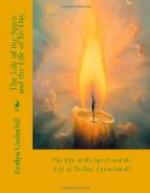The ending of this conflict, the self’s unification and establishment in the new life, commonly means a return more or less complete to that world from which the convert had retreated; taking up of the fully energized and fully consecrated human existence, which must express itself in work no less than in prayer; an exhibition too of the capacity for leadership which is the mark of the regenerate mind. Thus the “first return” of the Buddhist saint is “from the absolute world to the world of phenomena to save all sentient beings."[61] Thus St. Benedict’s and St. Catherine of Siena’s three solitary years are the preparation for their great and active life works. St. Catherine of Genoa, first a disappointed and world-weary woman and then a penitent, emerges as a busy and devoted hospital matron and inspired teacher of a group of disciples. St. Teresa’s long interior struggles precede her vigorous career as founder and reformer; her creation of spiritual families, new centres of contemplative life. The vast activities of Fox and Wesley were the fruits first of inner conflict, then of assurance—the experience of God and of the self’s relation to Him. And on the highest levels of the spiritual life as history shows them to us, this experience and realization, first of profound harmony with Eternity and its interests, next of a personal relation of love, last of an indwelling creative power, a givenness, an energizing grace, reaches that completeness to which has been given the name of union with God.
The great man or woman of the Spirit who achieves this perfect development is, it is true, a special product: a genius, comparable with great creative personalities in other walks of life. But he neither invalidates the smaller talent nor the more general tendency in which his supreme gift takes its rise. Where he appears, that tendency is vigorously stimulated. Like other artists, he founds a school; the spiritual life flames up, and spreads to those within his circle of influence. Through him, ordinary men, whose aptitude for God might have remained latent, obtain a fresh start; an impetus to growth. There is a sense in which he might say with the Johannine Christ, “He that receiveth me receiveth Him that sent me”; for yielding to his magnetism, men really yield to the drawing of the Spirit itself. And when they do this, their lives are found to reproduce—though with less intensity—the life history of their leader. Therefore the main characters of that life history, that steady undivided process of sublimation; are normal human characters. We too may heal the discords of our moral nature, learn to judge existence in the universal light, bring into consciousness our latent transcendental sense, and keep ourselves so spiritually supple that alike in times of stress and hours of prayer and silence we are aware of the mysterious and energizing contact of God. Psychology suggests to us that the great spiritual personalities revealed in history are but supreme instances of a searching self-adjustment and of a way of life, always accessible to love and courage, which all men may in some sense undertake.




